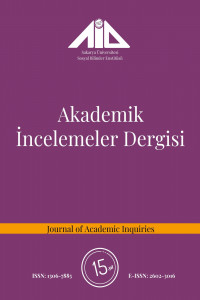Abstract
Diller farklı yöntemlerle fiilleri gruplandırırlar. Zazacanın ergatif özelliğinden dolayı fiillerin geçişli veya geçişssiz olmaları büyük rol oynamaktadır. Zaza Dili çift geçişli fiilleri geçişli ve geçişsiz fiilerden ayırdetmek için bazı zamirler devreye koyar. Bazı dilbilimsel eserlerde geçişli ve ergatif kavramı eşanlamlı olarak kullanılır. Bu makale, bu yapılarda bazı ilginç sözdizimsel unsurlara sahip olan Zaza dilindeki çift geçişli yapıları incelemeyi amaçlamaktadır. Çift geçişli fiilerdeki hedef ya da indirek nesnenin yerine kullanılan birçok zamir mevcuttur. Bu zamirler çoğunlukla yön partikelleri ile kombine edilirler. Bir yandan, bu çalışmanın amacı bu zamirlerin işlevlerini ortaya çıkarmaktır. Bu zamirlerin anlamsal içeriği, hangi zamirlerin belirli bir konumda görünebileceğine karar verir. Yön partikelleri Yönlü veya yönsüz görünebilirler. Sadece cı gibi zamirler tek başına bir NP'nin yerini alabilir, diğer zamirler bunun yerine geçmek için bir yön partikeline ihtiyaç duyar. Öte yandan, bu çalışma, dönüşümlü yapılarda morfosentaktik ve anlamsal gerçekleşmeleri tartışmaktadır. Bu zamirler sözdizimsel olarak aynı kelime sırasını takip etmese de, anlamsal olarak iki gruba ayrılabilirler.
Supporting Institution
Munzur Üniversitesi
Thanks
Teşekkür ediyor, kolaylıklar diliyorum.
References
- Arslan, İlyas. (2007). Partikeln in Zazaki. Unpuslished master thesis: Universität zu Köln. https://www.academia.edu/45028958/Partikeln_im_Zazaki
- Arslan, Ilyas. (2016). Ergativität und Fiilfunktionalität in der Zaza Sprache. PhD Thesis: https://docserv.uni-duesseldorf.de/servlets/DerivateServlet/Derivate-39270/Arslan_Dissertation_Submit_Bib_A1.pdf.
- Arslan, Ilyas. (2017). Zaza Dilindeki ergatif sistemin tarihi gelişimi. Munzur Üniversitesi Sosyal Bilimler Dergisi 4(8): 63-87.
- Durscheid, Christa. (2001). Verbsyntax und Rollensemantik. In Deutsche Sprache: ds; Zeitschrift für Theorie, Praxis, Dokumentation. 29(2): 176-185.
- Faghiri, Pegah & Samvelian, Pollet & Hemforth, Barbara. (2014). Accessibility and Word Order: The Case of Ditransitive Constructions in Persian. In Stefan Müller (Ed.): Proceedings of the 21st International Conference on Head-Driven Phrase Structure Grammar, University at Buffalo (pp. 217–237). Stanford, CA: CSLI Publications.
- Malchukov, Andrej & Haspelmath, Martin & Comrie, Bernard. (2007). Ditransitive constructions: A typological overview. Studies in Ditransitive Constructions: A Comparative Handbook. 10.1515/9783110220377.
- Haspelmath, Martin. (2008). Ditransitive constructions: Towards a new Role and Reference Grammar account? Investigations of the Syntax–Semantics–Pragmatics Interface, 75-100 (2008). 10.1075/slcs.105.09has.
- Haspelmath, Martin. (2015). Ditransitive constructions. In Annu. Rev. of Linguist. 1:19-41 https://www.annualreviews.org/doi/abs/10.1146/annurev-linguist-030514-125204.
- Plank, Frans. (1987). Direkte indirekte Objekte. Oder: Was uns lehren lehrt. Leuvense Bijdragen 76: 37-61.
- Selcan, Zülfü. (1998). Grammatik der Zaza-Sprache: Nord-Dialekt (Dersim-Dialekt). Berlin: Wissenschaft & Technik.
- Van Valin, Robert D., Jr. 2007. The Role and Reference Grammar Analysis of Three-Places Predicates- Suvremena Lingvistika 33.1.63:31-64.
Abstract
Languages group verbs in different ways. Because of the ergative feature of Zazaki, it plays a big role whether the verbs are transitive or intransitive. Zaza Language introduces some pronouns to distinguish double-transitive verbs from transitive and intransitive verbs. In some linguistic works, the terms transitive and ergative are used synonymously. This article aims to scrutinize ditransitive constructions in the Zaza language, which has some interesting syntactic elements in these structures. They are mostly pronouns in combination with directions. Several pronouns replace indirect object. On the one hand, the goal of this study is to find out the functions of these pronouns. The semantic content of these pronouns decides which pronouns may appear in a specific position. They can appear with or without directions. Only the pronouns such as cı can alone replace a NP, the other ones need a direction for this replacing. On the other hand, this study discusses the morphosyntactic and semantic realizations in ditransitive constructions. While these pronouns do not syntactically follow the same word order, they can semantically be classified into two groups.
References
- Arslan, İlyas. (2007). Partikeln in Zazaki. Unpuslished master thesis: Universität zu Köln. https://www.academia.edu/45028958/Partikeln_im_Zazaki
- Arslan, Ilyas. (2016). Ergativität und Fiilfunktionalität in der Zaza Sprache. PhD Thesis: https://docserv.uni-duesseldorf.de/servlets/DerivateServlet/Derivate-39270/Arslan_Dissertation_Submit_Bib_A1.pdf.
- Arslan, Ilyas. (2017). Zaza Dilindeki ergatif sistemin tarihi gelişimi. Munzur Üniversitesi Sosyal Bilimler Dergisi 4(8): 63-87.
- Durscheid, Christa. (2001). Verbsyntax und Rollensemantik. In Deutsche Sprache: ds; Zeitschrift für Theorie, Praxis, Dokumentation. 29(2): 176-185.
- Faghiri, Pegah & Samvelian, Pollet & Hemforth, Barbara. (2014). Accessibility and Word Order: The Case of Ditransitive Constructions in Persian. In Stefan Müller (Ed.): Proceedings of the 21st International Conference on Head-Driven Phrase Structure Grammar, University at Buffalo (pp. 217–237). Stanford, CA: CSLI Publications.
- Malchukov, Andrej & Haspelmath, Martin & Comrie, Bernard. (2007). Ditransitive constructions: A typological overview. Studies in Ditransitive Constructions: A Comparative Handbook. 10.1515/9783110220377.
- Haspelmath, Martin. (2008). Ditransitive constructions: Towards a new Role and Reference Grammar account? Investigations of the Syntax–Semantics–Pragmatics Interface, 75-100 (2008). 10.1075/slcs.105.09has.
- Haspelmath, Martin. (2015). Ditransitive constructions. In Annu. Rev. of Linguist. 1:19-41 https://www.annualreviews.org/doi/abs/10.1146/annurev-linguist-030514-125204.
- Plank, Frans. (1987). Direkte indirekte Objekte. Oder: Was uns lehren lehrt. Leuvense Bijdragen 76: 37-61.
- Selcan, Zülfü. (1998). Grammatik der Zaza-Sprache: Nord-Dialekt (Dersim-Dialekt). Berlin: Wissenschaft & Technik.
- Van Valin, Robert D., Jr. 2007. The Role and Reference Grammar Analysis of Three-Places Predicates- Suvremena Lingvistika 33.1.63:31-64.
Details
| Primary Language | English |
|---|---|
| Journal Section | Reserch Articles |
| Authors | |
| Publication Date | October 15, 2021 |
| Submission Date | June 1, 2021 |
| Published in Issue | Year 2021 Volume: 16 Issue: 2 |
Cite
This work is licensed under a Creative Commons Attribution-NonCommercial 4.0 International Licence.
Journal of Academic Inquiries accepts the Open Access Journal Policy for sharing knowledge.


